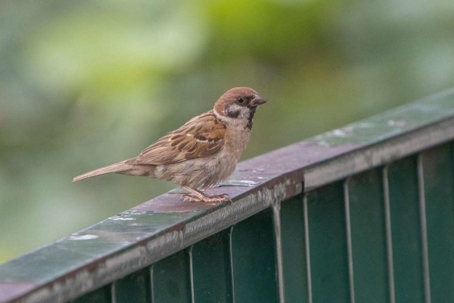What Do Sparrows Look Like?
Sparrows are small, passerine birds known for their compact and unassuming appearance. Their appearance can vary slightly depending on the specific species, but here is a description of the common house sparrow (Passer domesticus) as a reference:
House sparrows typically measure about 5.5 to 6.3 inches (14 to 16 centimeters) in length, with a wingspan of approximately 7.5 to 9.1 inches (19 to 23 centimeters). They have a plump and stocky body with a relatively short tail. The most distinguishing features of sparrows include:
Coloration: Male house sparrows have a bright and distinctive plumage with a chestnut-brown back, grayish crown, and white cheeks and underparts. They also have a black throat "bib" and a small black patch on their chin. During the breeding season, their plumage becomes even more vibrant. In contrast, female house sparrows are generally duller and lack the bold coloring of the males.
Beak: Sparrows have a short, conical beak that is adapted for cracking seeds. The beak is usually dark in color.
Eyes: Their eyes are dark and relatively small in proportion to their head.
Wings: Sparrows have rounded wings, which allow for quick and agile flight. The wings are typically brown with faint streaks.
Legs and Feet: Their legs are relatively short and sturdy, equipped for perching and hopping. The feet are adapted for gripping branches and ledges.
Tail: The tail of a sparrow is short and squared off, with brown feathers.
Size: Sparrows are among the smaller bird species, making them easily distinguishable from larger birds.
Sparrows belong to a diverse family of birds, Passeridae, and there are various species worldwide, each with its own unique characteristics. While the description above primarily focuses on the house sparrow, other species may exhibit variations in size, coloration, and markings. Nonetheless, the common house sparrow is one of the most recognizable and frequently encountered sparrows in urban and suburban areas.
How Big Are Sparrows?
Sparrows are generally small birds, and their size can vary slightly depending on the specific species, but the average size of sparrows falls within the following approximate measurements:
Length: Sparrows typically measure about 4.3 to 7.9 inches (11 to 20 centimeters) in length from the tip of their beaks to the end of their tails.
Wingspan: Their wingspan ranges from approximately 6.7 to 9.8 inches (17 to 25 centimeters). The wings are relatively short and rounded, allowing for agile flight.
Weight: Sparrows are lightweight birds, with most species weighing between 0.4 to 1.2 ounces (12 to 34 grams). Their weight can vary based on factors such as age, sex, and diet.
There are numerous species of sparrows found across the world, and while they share common characteristics, there can be variations in size among these species. The size measurements provided here are generally applicable to many sparrows, including the common house sparrow, but specific measurements may differ slightly for other species within the sparrow family (Passeridae). Nonetheless, sparrows are characterized by their small and compact stature, making them easily distinguishable from larger bird species.
What Color Are Sparrows?
Sparrows exhibit a range of colors, but their plumage tends to be relatively subdued and cryptic, providing them with camouflage in their natural habitats. The specific colors of sparrows can vary depending on the species and, in some cases, the age and sex of the bird. Here are the common coloration patterns for sparrows:
Brown and Gray: Many sparrows, including the house sparrow, feature various shades of brown and gray in their plumage. The back and wings of sparrows are typically brown with streaks or mottling, helping them blend into grassy and shrubby environments.
White: Sparrows often have white or pale underparts, including the throat, belly, and vent area. The extent of white on the underparts can vary among species.
Black Markings: Some sparrows have distinct black markings on their faces and throats. For example, the male house sparrow has a black throat "bib" and a small black patch on its chin. These black markings can be more pronounced during the breeding season.
Chestnut or Rufous: In certain species, such as the American tree sparrow, you may find chestnut or rufous-colored crowns or markings on their heads.
Yellow or Orange: Some sparrows, like the Savannah sparrow, display yellow or orange patches or streaks on their face, crown, or breast.
Green or Olive: A few species, like the green-tailed towhee, have green or olive-colored plumage in certain areas.
Blue: The male indigo bunting, while not a true sparrow but often associated with them, is known for its vibrant blue plumage during the breeding season.
Gray or Blue-Grey: In some species, such as the white-crowned sparrow, you can observe gray or blue-gray markings on the head.
Sparrows encompass a diverse group of species, and coloration can vary significantly between them. Additionally, female sparrows of many species tend to have more subdued and cryptic plumage compared to their male counterparts. These subtle colors are advantageous for sparrows as they often inhabit grasslands, shrublands, and urban environments where blending into their surroundings is essential for survival.

